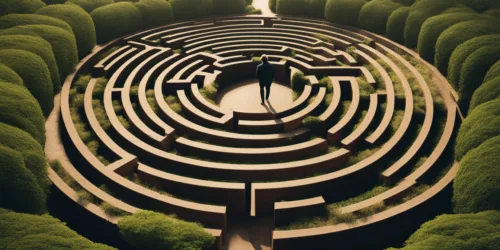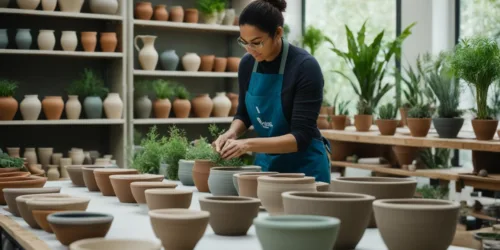Mindfulness in Stone Carving: Creative Serenity
Welcome to our exploration of mindfulness in stone carving. In this article, we will delve into the serene and meditative practice of stone carving and how it can be a transformative experience. Beyond being a creative art form, stone carving is a mindful journey that allows us to connect deeply with the material, our intentions, and our inner selves. Join us as we uncover the techniques, benefits, and power of mindfulness in the world of stone carving.
Stone carving meditation involves focusing our attention and intention on the stone, allowing our minds to enter a state of calm and serenity. It requires patience, concentration, and a profound connection with the material. As we carve, we make deliberate and deliberate strokes, observing and working with the stone’s natural shape and texture. Through this mindful sculpting process, we can achieve a sense of inner peace and harmony.
Key Takeaways:
- Mindfulness in stone carving is a practice that brings together creativity and serenity.
- Stone carving techniques require patience, concentration, and a deep connection with the material.
- Carving stone mindfully can reduce stress, promote relaxation, and provide therapeutic benefits.
- Techniques for mindful stone carving include observing the stone’s natural shape, working with the material, and maintaining a relaxed breathing pattern.
- Mindfulness in stone carving can lead to self-discovery, transformation, and a deeper understanding of ourselves and the world.
The Therapeutic Benefits of Stone Carving
Stone carving has been found to have numerous therapeutic benefits. It goes beyond being a creative art form and becomes a mindful and meditative practice. The process of carving stone requires a focused and meditative state of mind, allowing individuals to achieve a sense of calm and clarity.
As individuals engage in the physically demanding task of sculpting the stone, they also find release and expression. Stone carving becomes a form of therapy, allowing artists to channel their emotions and find solace in the creative process. The act of transforming a solid piece of stone into a work of art can be incredibly cathartic.
Moreover, the repetitive motions and mindful attention required in stone carving can induce a state of flow. In this state, artists become fully absorbed in the task at hand, finding themselves in a timeless zone of focused creation. This process promotes relaxation and a deep sense of satisfaction.
The therapeutic benefits of stone carving extend to reducing stress and anxiety. By immersing themselves in the calming stone carving process, individuals can find respite from the pressures of daily life. Engaging in mindful creation in stone carving allows artists to disconnect from their worries and connect with the present moment.
Mindfulness Artistry: A Quote
“Stone carving is a transformative journey that merges mindfulness and artistry. The calming nature of the process invites us to fully engage our senses, creating a space for self-expression and reflection.” – Lucinda Green, mindfulness artist
Through mindful attention in stone carving, artists can harness the therapeutic power of the practice, bringing tranquility and beauty into their lives and their creations.
Techniques for Mindful Stone Carving
Mindful stone carving is an art that requires specific techniques to cultivate focus, presence, and a deep connection with the stone. By incorporating these techniques into your practice, you can enhance your sculpting experience and promote mindfulness and serenity.
1. Start with a Clear Intention
Before you begin carving, set a clear intention for your artwork. Think about the emotions, ideas, or messages you want to convey through your sculpture. This intention will guide your creative process and infuse meaning into your work.
2. Observe the Stone’s Natural Shape and Texture
Take a moment to closely observe the stone before you start carving. Notice its natural shape, texture, and unique characteristics. By working with the stone’s inherent qualities, you can create a harmonious sculpture that complements the material’s essence.
3. Work with the Material, Not Against It
Instead of trying to impose your will onto the stone, embrace a mindset of collaboration and respect. Allow the stone to guide your sculpting decisions, working in harmony with its natural structure. This approach will yield more organic and flowing shapes, enhancing the beauty of your artwork.
4. Practice Slow and Deliberate Movements
Engage in mindful sculpting by slowing down your movements and paying attention to each stroke. Focus on the sensations created by your tools and the stone, immersing yourself in the tactile experience. This deliberate and intentional approach will deepen your connection with the carving process.
5. Maintain a Relaxed Breathing Pattern
Throughout your stone carving session, be aware of your breath and maintain a relaxed and steady breathing pattern. This rhythmic breathing will help you stay centered, grounded, and in the present moment. It can also serve as an anchor, bringing your focus back whenever your mind starts to wander.
By incorporating these techniques into your stone carving practice, you can transform it into a mindful and meditative experience. These mindful sculpting techniques will enable you to cultivate a deep connection with the stone, embrace the present moment, and discover a sense of inner peace and serenity.

The Transformative Power of Mindfulness in Stone Carving
Mindfulness in stone carving has the power to not only shape the stone but also shape our inner selves. When we approach the process of carving with mindful attention, we open ourselves up to a deeper understanding of who we are and the world around us. It becomes a journey of self-discovery and transformation, unveiling the beauty within the stone and within ourselves.
Through mindfulness, we cultivate a non-judgmental and compassionate exploration of our emotions, thoughts, and sensations. As we carve the stone, we become acutely aware of the present moment, fully immersed in the creative process. The act of carving itself becomes a form of meditation, allowing us to find solace in the rhythmic movements and the tactile sensations of the stone.
With mindful attention, our carving becomes an intentional practice, where each stroke carries meaning and purpose. We observe the stone’s natural shape and texture, working in harmony with it rather than against it. By paying close attention to each stroke, each chisel mark, we create a sculpture that is not only a reflection of our artistic expression but also a reflection of our journey towards self-discovery and inner peace.
As we tap into our creative flow, mindfulness in stone carving becomes a transformative experience. It opens the door to a deeper connection with ourselves and the world, allowing us to find a sense of peace and fulfillment. Through the mindful attention we bring to each carving session, we create not only beautiful works of art but also a space for introspection and self-reflection. Mindfulness in stone carving is a practice that goes beyond the physical act of carving; it is a journey that touches our hearts and souls.
FAQ
What is mindfulness in stone carving?
Mindfulness in stone carving is a practice that involves focusing one’s attention and intention on the stone, allowing the mind to enter a state of calm and serenity. It is a mindful and meditative approach to sculpting, requiring patience, concentration, and a deep connection with the material.
What are the therapeutic benefits of stone carving?
Stone carving has numerous therapeutic benefits. It can reduce stress, anxiety, and promote relaxation. The process of carving stone requires a focused and meditative state of mind, helping individuals achieve a sense of calm and clarity. Sculpting also serves as a form of release and expression, allowing artists to channel their emotions and find solace in the creative process.
What techniques are used in mindful stone carving?
Mindful stone carving involves specific techniques that promote focus and presence. These techniques include starting with a clear intention, observing the stone’s natural shape and texture, and working with the material rather than against it. It requires slow and deliberate movements, paying attention to each stroke and the sensations it creates. Maintaining a relaxed breathing pattern throughout the process is also crucial.
How does mindfulness in stone carving transform the artist?
Mindfulness in stone carving not only transforms the artwork but also the artist. It leads to a deeper understanding of oneself and the world, allowing for the exploration of emotions, thoughts, and sensations in a non-judgmental and compassionate way. Mindfulness in stone carving can serve as a form of meditation, providing space for introspection and self-reflection. It taps into the artist’s creative flow and brings a sense of peace and fulfillment.






